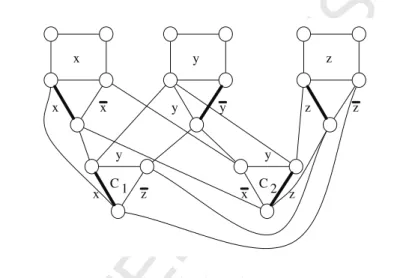Contraction and deletion blockers for perfect graphs and H-free graphs
Texte intégral
Figure



Documents relatifs
In particular, since a bipartite graph is a perfect graph as well as a (0,2)-colorable graph, then the Maximum Weighted Independent Set problem is polynomial on bipartite
A note on the hardness results for the labeled perfect matching problems in bipartite graphs..
Since every edge of a bridgeless cubic graph is contained in a perfect matching (see [10]) the minimum number τ(G) of perfect matchings covering its edge set is well
Lemma 4.1. Since the problem is auto-complementary, we consider only the cases of bipartite graphs, line trigraphs and doubled trigraphs. A clique in a bipartite trigraph is an edge,
In this paper, we provide a theorem that, for a given signed bipartite graph (B, Π) of unbalanced- girth 2k, helps to decide whether every signed bipartite K 4 -minor-free graph
As for Section 5, it is dedicated to proving that the Strong Erd˝ os- Hajnal property holds in perfect graphs with no balanced skew-partition, and then in classes of trigraphs closed
The problem of recognizing localizable graphs is polynomially solvable within each of the following graph classes: cubic graphs, C 4 -free semi-perfect graphs, cocomparability
Malyshev, The complexity of the vertex 3-colorability problem for some hereditary classes defined by 5-vertex forbidden induced subgraphs, Graphs Comb. Szwarcfiter, Characterizing